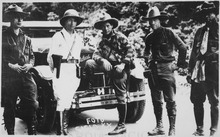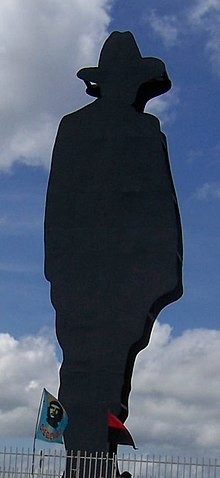Augusto César Sandino
Augusto César Sandino (born May 18, 1895 in the hamlet of San Rafael del Norte in the municipality of Niquinohomo ( Dept. Masaya ), Nicaragua ; † February 21, 1934 in Managua ) was a guerrilla leader , head of the Nicaraguan resistance against the US occupation in Nicaragua and a defender of Hispanic Americanism .
Life
Sandino was born as Augusto Nicolás Calderón Sandino in the Nicaraguan village of Niquinohomo, the illegitimate son of Gregorio Sandino, a coffee farmer who works as an administrator with his own small estate, and Margarita Calderón, a mestizo and employee of his father's plantation. When he was nine, his mother sent him to his grandmother, where he lived for a few years until a few years later he lived and worked with his father's family. His first job consisted of transporting agricultural products to the surrounding cities.
At the age of 17, in July 1912, Sandino witnessed the first intervention of American forces in Nicaragua. These came to the aid of President Adolfo Díaz against an uprising by General Benjamin Zeledón . Zeledon, who was shot by American soldiers, became his model. On June 20, 1920 , Sandino Dagoberto Rivas, the son of a member of the Partido Conservador , shot a revolver in the left leg during a violent dispute over a bean sale .
Migrant workers in the north
Sandino took the train to La Ceiba around 1921 . First he worked in gold mining, then he was employed as a guard in the rum warehouse of an Ingenio Montecristo of the Honduras Sugar & Distilling Company . In the further course of 1923 Sandino went to Quiriguá in Guatemala, where he worked as a servant or mechanic in a banana plantation for the United Fruit Company . Later that year, Sandino went to Tampico , Mexico, where he worked for the South Penn Oil Company. In 1925 he went to the Huasteca Petroleum Company camp in Cerro Azul in Vera Cruz and headed the gasoline sales department. By 1926 he had established first contacts with members of the local Masonic Lodge . At the time, he had savings of around $ 5,000.
Guerra Constitucionalista
In June 1926, Sandino returned to Nicaragua and worked in the mining industry near San Albino in Nueva Segovia . For an uprising by the Partido Liberal against the government of Emiliano Chamorro Vargas and his successor Adolfo Díaz , US marines landed in the port of Corinto in August 1926 and began the second US intervention in Nicaragua and thus the later so-called Guerra Constitucionalista . In a mine of a US corporation in San Albino, Sandino, as secretary to the paymaster, recruited his colleagues for a Grupo Armado Liberal (armed liberation group). On November 2, 1926, he failed with 29 colleagues in an attack on the city of El Jícaro in the north of the country. Then his troops withdrew to El Chipote on the Río Coco in the department of Nueva Segovia. Carleton Beals of The Nation accompanied the Ejército Defensor de la Soberanía de Nicaragua from February 22 to April 18, 1928. In April 1928, the Grupo Armado Liberal occupied mines of G. Fred & D. Watson Fletcher on the Río Pis Pis , Nicaragua, and ignite them. In 1928 Farabundo Martí was a representative of the League Anti-imperialista de las Americas with five other workers from El Salvador in Sandino's troops, then he founded the Hands Off Nicaragua Committee . President Calvin Coolidge sent 6,000 Marines to Nicaragua, the officers told the Marines, “ Get Sandino dead or alive! "(German" Grab Sandino dead or alive! "). The sixth congress of the Communist International in Moscow in 1928 recognized Sandino's struggle as heroic.
Pacto del Espino Negro
The generals of the Partido Liberal José María Moncada and Juan Bautista Sacasa fought until May 4, 1929, then they concluded the Pacto del with Henry L. Stimson , sent by US President Calvin Coolidge, under a plum tree (Spanish: Espino Negro ) at Tipitapa Espino Negro . After Díaz's tenure, Moncada and then Sacasa were allowed to become president.
General de Hombres Libres
As General de Hombres Libres (General of the Free Men) Sandino continued the fight in the north with the members of the Ejército Defensor de la Soberanía Nacional (EDSN), which depending on the situation were 2,000 to 6,000 fighters. In June 1929 Sandino came to Mérida . According to Times Magazine , Sandino was responsible for killing 135 U.S. Marines . On January 2, 1933, one day after Sacasa took office as President, the US Marines withdrew from Nicaragua as agreed. Before that, they had set up and trained a Nicaraguan National Guard , whose command lay with their confidante Anastasio Somoza García .
Cooperative on the Río Coco
After the US troops withdrew, the EDSN laid down its arms and operated a plantation as a cooperative, which they had requested. During a banquet in Managua, to which President Sacasa had invited Sandino and his officers on February 21, 1934, they were murdered by the National Guard Anastasio Somoza Garcías. The representative of the Ejército Defensor de la Soberanía de Nicaragua in Mexico was Dr. Pedro José Zepeda.
Culture of remembrance
In 1961, the Frente Sandinista de Liberación Nacional was named after him, based on his ideas and has now registered utility models on his name .
The Augusto C. Sandino International Airport in Managua and the Avenida Augusto Sandino are named after him. In 1990 a sculpture by Sandino in the style of a silhouette was erected on the Loma de Tiscapa .
See also
literature
- Thomas Fischer, Anneliese Sitarz: The limits of the "American Dream". Hans Sitarz as a 'money doctor' in Nicaragua 1930–1934 (= Latin American Studies. Volume 50). Iberoamericana / Vervuert, Frankfurt am Main 2008, ISBN 978-3-86527-420-5 .
- Neill Macaulay: The Sandino affair . Durham, NC (Duke University Press) 1985 (Chicago first edition, Quadrangle Books 1967). ISBN 0-8223-0696-4 .
- Bernard C. Nalty: The United States Marines in Nicaragua 1910–1933. US Marine Corps, Washington 1968 (digitized version) .
- Alan L. McPherson: The invaded. How Latin Americans and their allies fought and ended US occupations. Oxford University Press, Oxford u. a. 2014, ISBN 978-0-19-534303-8 .
- Frank Niess: Sandino. General of the Oppressed . Cologne 1989, ISBN 3-7609-1242-7 .
- Sergio Ramírez : Viva Sandino! Wuppertal 1976, ISBN 3-87294-077-5 .
- Michael Rediske: Change in Nicaragua . Berlin 1984, ISBN 3-923020-04-X .
- Volker Wünderich: Sandino. A political biography . Wuppertal 1995, ISBN 3-87294-696-X .
- Volker Wünderich: Augusto César Sandino. In: Nikolaus Werz (ed.): Populists, revolutionaries, statesmen. Politicians in Latin America. Frankfurt am Main 2010, ISBN 978-3-86527-513-4 , pp. 278-297.
Movies
- Sandino (Chile / Spain / Cuba / Mexico / Nicaragua 1990, German title Sandino - a life for Nicaragua ), directed by Miguel Littín , with Kris Kristofferson as Tom Holte, Joaquim de Almeida as Sandino, Dean Stockwell as Captain Hatfield, Ángela Molina as Teresa Villatoro and Victoria Abril as Blanca Arauz. German first broadcast on November 21, 1995 on SAT 1 .
- Flieger (USA 1929, directed by Frank Capra , with Jimmy de la Cruze as "Lobo" Sandino).
Web links
- Literature by and about Augusto César Sandino in the catalog of the Ibero-American Institute in Berlin
- Literature by and about Augusto César Sandino in the catalog of the German National Library
- Newspaper article about Augusto César Sandino in the 20th century press kit of the ZBW - Leibniz Information Center for Economics .
- Augusto César Sandino, (1895–1934)
- Augusto César Sandino biography (Spanish)
- Newsreel footage of American troop transports to Nicaragua in 1928 , published by British Pathé under the title Uncle Sam's little war , January 16, 1928
Individual references / comments
- ↑ a b c d e f g h i j Leslie Manigat : L'Amérique latine au XXe siècle - 1889–1929 . In: Points Histoire . H146. Éditions du Seuil, Paris 1991, ISBN 978-2-02-012373-0 , pp. 395 ff . (première édition en 1973 aux Éditions Richelieu, collection L'Univers contemporain ).
- ^ [Neill Macaulay, The Augusto Affair, (Chicago: Quadrangle Books, 1967) p. 49]
- ↑ Algunas facetas del general Augusto C. Sandino. ( Memento of June 9, 2008 in the Internet Archive ) In: La Prensa. June 7, 2003.
- ↑ El Jícaro: ruta de la historia In: El Nuevo Diario , March 5, 2004.
- ↑ Our Century: The Twenties ( Memento of March 11, 2007 in the Internet Archive ) In: The Nation. December 23, 1999.
- ↑ Coordinates: Latitude: 14 ° 15 '0 N, Longitude: 84 ° 35' 60 W
- ^ Brothers' Plight. In: Time. May 7, 1928.
- ↑ Pirates: Samaritans. In: Time. May 28, 1928.
- ↑ Not a Jot, Not a Tittle. In: Time. November 12, 1928.
- ^ Prosperous Sandino. In: Time. September 9, 1929.
- ^ Sandino Presents Arms. In: Time. February 13, 1933.
- ↑ Murder at the Crossroads. In: Time. March 5, 1934.
- ^ Death at the Cross Roads (Cont'd). In: Time. April 16, 1934.
| personal data | |
|---|---|
| SURNAME | Sandino, Augusto César |
| ALTERNATIVE NAMES | Sandino, Augusto Nicolás Calderón |
| BRIEF DESCRIPTION | Guerrilla leader, revolutionary, head of the Nicaraguan resistance against the US occupation in Nicaragua |
| DATE OF BIRTH | May 18, 1895 |
| PLACE OF BIRTH | Niquinohomo |
| DATE OF DEATH | February 21, 1934 |
| Place of death | Managua |




